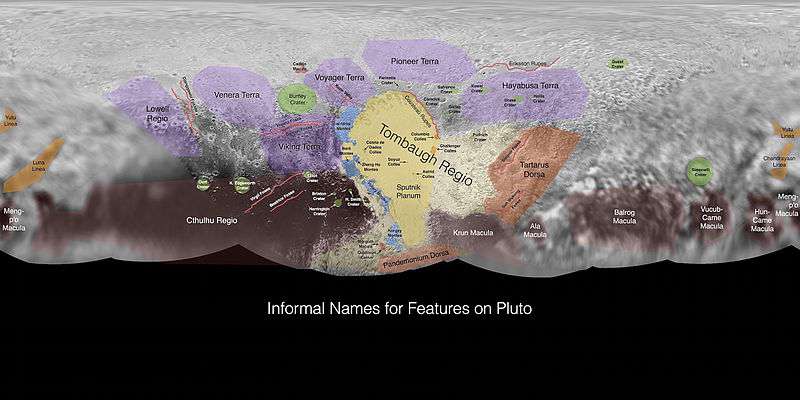Norgay Montes
The Norgay Montes (;[note 1] less officially, Norgay Mountains) are icy mountains, near the Hillary Montes, that reach 3.4 km (2.1 mi; 11,000 ft) above the surface of the dwarf planet Pluto,[3][4] bordering the southwest region of Sputnik Planitia in the south of Tombaugh Regio (or the part of Tombaugh Regio south of the equator).[5][6] The mountains, first viewed by the New Horizons spacecraft on 14 July 2015, and announced by NASA on 15 July 2015, are named after the Nepalese mountaineer Tenzing Norgay, who, along with Sir Edmund Hillary, were the first climbers to reach the summit of the highest peak on Earth, Mount Everest (29 May 1953).[1][2][7]
Understanding size
| Mountain |
km high |
|---|
| Everest (btp) | 4.6 |
| Fuji | 3.8 (asl) |
| Norgay | 3.4 |
| Zugspitze | 3 |
|
The Norgay Montes rise to 3.4 km (2.1 mi; 11,000 ft) high,[8] about twice as high as the Hillary Montes. In comparison, Mount Everest rises 4.6 km (2.9 mi; 15,000 ft) base-to-peak (though to an altitude of 8.8 km (5.5 mi; 29,000 ft) above sea level).[9] Japan's Mount Fuji is closer, at about 3.8 km (2.4 mi; 12,000 ft) in altitude.
Gallery
| Norgay Montes on Pluto
(closeup; 14 July 2015). |
|
Videos
Pluto flyover (July 14, 2015)
(00:30; released September 18, 2015) (00:50; released December 5, 2015) See also
Notes
References
- 1 2 Nemiroff, R.; Bonnell, J., eds. (18 July 2015). "Fly Over Pluto". Astronomy Picture of the Day. NASA. Retrieved 27 July 2015.
- 1 2 Staff (17 July 2015). "NASA – Video (01:20) – Animated Flyover of Pluto's Icy Mountain and Plains". NASA & YouTube. Retrieved 18 July 2015.
- ↑ Kremer, Ken (27 July 2015). "Breathtaking Pluto images reveal icy dwarf planet's plains and mountains (+video) - NASA's New Horizons space probe has sent back its highest-resolution images yet of Pluto and its moons.". The Christian Science Monitor. Retrieved 17 August 2015.
- ↑ Akpan, Nsikan (18 July 2015). "Nepal gets a piece of Pluto plus four new surprises from New Horizons". PBS NewsHour. Retrieved 17 August 2015.
- ↑ Staff (25 July 2015). "Pluto mountain range named after Sir Edmund Hillary". Stuff.co.nz. Retrieved 17 August 2015.
- ↑ Staff (24 July 2015). "NASA names Pluto's mountains after Sir Edmund Hillary". Television New Zealand. Retrieved 17 August 2015.
- ↑ Pokhrel, Rajan (19 July 2015). "Nepal's mountaineering fraternity happy over Pluto mountains named after Tenzing Norgay Sherpa - Nepal's First Landmark In The Solar System". The Himalayan Times. Retrieved 19 July 2015.
- ↑ Wall, Mike (21 July 2015). "Second Mountain Range Rises from Pluto's 'Heart' (Photo)". Space.com. Retrieved 18 August 2015.
- ↑ Mount Everest (1:50,000 scale map), prepared under the direction of Bradford Washburn for the Boston Museum of Science, the Swiss Foundation for Alpine Research, and the National Geographic Society, 1991, ISBN 3-85515-105-9
- ↑ Gipson, Lillian (24 July 2015). "New Horizons Discovers Flowing Ices on Pluto". NASA. Retrieved 25 July 2015.











.jpg)